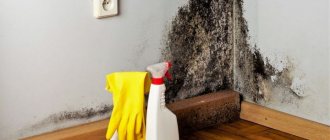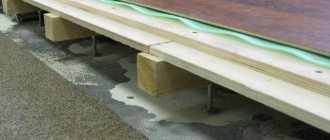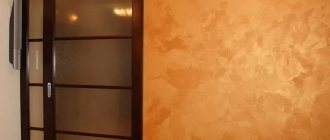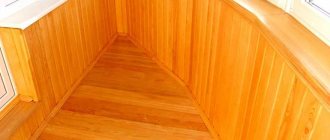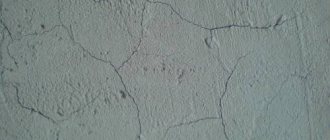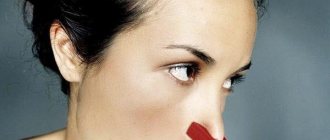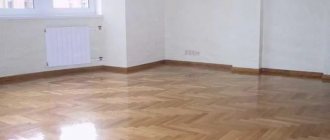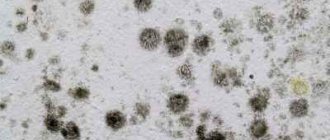As soon as mold appears on various surfaces of the apartment, it should be removed immediately. Otherwise, it will not only spoil the appearance of the walls, but will also have a very negative impact on the health of all household members. To remove mold from wallpaper, it is not necessary to re-glue it. Under certain conditions, you can do without cosmetic repairs by simply using industrial fungicides or home remedies. But simply disinfecting the room will not be enough. In order to completely destroy mold, it is necessary to create unfavorable conditions in the apartment for its proliferation - reduce humidity, increase temperature and allow sunlight to freely penetrate the rooms. It is this set of measures that will allow us to completely forget about this problem.
What is mold and its harm to humans?
Mold is a colony of toxic single-celled fungi. Their spores are extremely dangerous to human life and health. Once in a favorable environment (optimal conditions: absence of light, oxygen flow, high humidity), the spores multiply very quickly and enter the human body by air, provoking:
- a sharp deterioration in general health;
- constant headaches;
- development of acute allergic reactions;
- decreased human immunity;
- the appearance of diseases of the respiratory system.
Pregnant women, young children and people with weakened immune systems are most at risk.
Reasons for appearance
Factors contributing to the development of mold fungi:
- High humidity.
- Lack of ventilation. The lack of fresh air flow (hermetically sealed windows) creates a favorable environment for the development of pathogenic microorganisms.
- Furniture moved close to the walls disrupts natural air circulation.
- Lack of insulation (sharp temperature difference in the wall). Violations of the construction process, insufficient waterproofing of floors (and sometimes its complete absence) lead to sharp temperature changes in the wall in the autumn-winter period, which has a beneficial effect on the proliferation of mold fungi.
- The influence of dampness from the basement or poor insulation on the roof. For residents of the first and last floors of apartment buildings, the problem of mold is known. This is because leaking floors, roofs, and damp basements are an ideal environment (damp and dark) for the growth of mold fungi.
Where is mold most likely to be found in a home?
In a private home, stains can appear everywhere - on the floor, ceiling, in corners, on furniture. It depends on where exactly the problem is.
It's a little easier with an apartment. Mold usually appears in high-rise buildings:
- In the bathroom, where the microclimate is ideal for her. If there is no or poor hood without draft in the bathroom, and the door is closed all the time, then mold will appear in a couple of months.
- On plastic windows. The reason is condensation due to temperature changes.
- Stains appear on corners and walls due to poor waterproofing of concrete slabs and poor ventilation.
Mold under wallpaper after renovation
There are several reasons why mold fungi appear immediately after repairs:
- Use of low-quality, already contaminated building materials. Most often these are sheets of plasterboard, the layered structure of which perfectly preserves pathogenic microorganisms.
- Installation of super-tight metal-plastic window blocks.
- Mistakes made by craftsmen during repairs. So, by gluing new wallpaper onto damp plaster or putty, after a while you can find fresh traces of mold on the decorative wall.
Useful tips
Useful tips will also help you avoid the appearance of mold:
- The basement must be well insulated, and interpanel seams must be repaired if necessary.
- Give preference to hinged models of metal-plastic windows, which will provide effective ventilation.
- It is advisable to install an additional hood.
- If there is groundwater and melt water in the basement, the problem should be eliminated to prevent it from entering the apartment.
- Try to complete the repairs before the onset of autumn or start gluing wallpaper after turning on the central heating.
It is not easy to destroy mold on wallpaper on your own, but it is possible if you follow all the recommendations. If possible, you should seek help from professionals. When starting a renovation, before gluing the wallpaper, you need to treat the walls with an antiseptic solution in order to prevent the appearance of mold in the future.
How to stop the spread
You can stop the development of mold colonies:
- saturating the room with sunlight and air;
- installing a forced ventilation system;
- providing an influx of warm, dry air (temperature 20-23C). Electric heating devices will come to the rescue;
- Having eliminated sources of dampness, carry out wet cleaning more often using antibacterial drugs.
Mold in the washing machine: diagnosis or death sentence?
Mandatory protective equipment
When treating surfaces with antibacterial drugs, it is very important to use personal protective equipment:
- specialized clothing (robe, overalls);
- respirator (protects the respiratory system);
- special glasses;
- latex gloves.
When cleaning walls, ceilings, and floors, it is important to ensure that the room is well ventilated. It is necessary to avoid contact of antiseptics and antifungal drugs with the skin. After finishing work, be sure to take a shower.
How to detect mold under wallpaper
Mold colonies appear very quickly. The first signs that fungal spores are growing under the wallpaper will be small black spots on the surface. Most often they can be seen in corners, on the wall behind furniture.
In the room where mold fungi develop, there is a rather persistent, very unpleasant smell of mustiness and dampness. Upon entering, you feel like you are entering a basement.
What to do if the affected area is huge?
If you accidentally looked behind a closet or modular cabinet furniture, and literally all the wallpaper there changed its color to gray-black, the sequence of actions is as follows:
- Make this room temporarily uninhabited, remove all furniture, which should also be treated with fungicidal agents.
- Open the window and ventilate the room well.
- Remove the wallpaper, place it neatly in a bag and immediately take it out of the living room.
- Dry the walls using hot air and ultraviolet light.
- Proceed with processing using all possible means, alternating them with each other.
- After each treatment, let the wall dry completely.
- Be sure to clean the floor in this room several times a day using chlorine-containing products, as fungal spores can settle on the surface.
Be sure to establish what exactly caused the massive development of fungus under the wallpaper, paying attention to such nuances as:
Drying laundry in large quantities
Makes the air humid, which is especially good for the development of fungus under the wallpaper. Take your laundry out onto the balcony or street, or use a household dryer.
Dampness of the outer wall
It is necessary to insulate it in any convenient way, otherwise the temperature difference in winter will provoke condensation, especially in the corners, which will create the most comfortable conditions for mold. In the blink of an eye, huge circles grow from the black dot.
Cold floor and lack of proper heating
The drier the air, the worse it is for mold.
Use humidifiers wisely, ensuring the humidity does not exceed the recommended humidity.
If there was plaster under the wallpaper, it will have to be removed. The task is not easy, but you will have to bother, otherwise subsequent wallpapers will suffer the same fate.
How to deal with large-scale pollution
When mold has grown not only into the wallpaper, but also into the layer of plaster, following a clear algorithm of actions will help eliminate the problem.
Removing wallpaper
Rip off contaminated coverings ruthlessly. If fungi have grown into the layer of plaster, hopes that black stains from the wallpaper can be removed with a damp cloth are in vain.
Mechanical cleaning of walls
Using a spatula, remove the layer of plaster under those parts of the decorative coating that have become infected.
Treatment of walls with construction chemicals against fungus
There is a fairly wide selection of anti-mold drugs available to the consumer (Fitoline, Xiolate). Having chosen the most suitable composition for yourself, the product is diluted with water according to the manufacturer’s instructions and the affected areas of the decorative coating are treated. Experts recommend re-treatment no earlier than six hours after the first.
Subsequent treatment of walls with antiseptics
Upon completion of treatment with an antifungal solution, the wallpaper is additionally coated with special antiseptic agents. They are presented to the consumer in a large assortment, and there is no need to breed them. An antiseptic prevents the appearance of fungus.
Puttying walls and wallpapering
After the dark spots of mold have been removed, you can begin decorating the surface. First, it is treated with finishing putty, and then covered with new wallpaper.
Degree of infection
The previous instructions suggest radical methods of control - remove all contaminated materials. If you add preventive methods to this, then you can get rid of the fungus once and for all, contrary to the common myth that says that mold cannot be killed.
But is there really a need for such difficult and costly actions to destroy mold under the wallpaper? What to do if fungi appear in a small area?
The critical figure is considered to be 20% of surface damage. If the colony has grown to this size, then radical measures will have to be taken. Otherwise, you can try to kill the fungus from the outside - burn it out with bleach, vinegar or a special spray. Such measures can be crowned with success, especially if the wallpaper is not multi-layered and not embossed, otherwise the mold will persist and will soon grow.
But what you definitely cannot do is mask the stain - cover it with new decoration, painting or furniture. This will make the situation even worse.
How to remove local manifestations of mold
You can quickly and effectively remove local foci of mold fungi by following a clear algorithm of actions:
- Determine the location of mold fungi.
- Wipe the infected area of the wallpaper with a damp sponge.
- Treat dark spots with hydrogen peroxide or diluted sting solution.
- Dry the treated area of wallpaper very well.
- Carry out wet cleaning in the room, treat the infected area with an ultraviolet lamp.
- Check ventilation. Move the furniture slightly away from the wall.
Fungus in the bathroom - causes, consequences and solutions
Prices for removing mold from walls
| Room area | Impregnation | Mechanical stripping | Disinfection from spores | Microwave drying of walls | Complex (3 year warranty) |
| 1-2 sq.m. | from 1000 rub. | from 1000 rub. | from 500 rub. | from 2000 rub. | from 3500 rub. |
| 3-5 sq.m. | from 800 rub. | from 850 rub. | from 350 rub. | from 2000 rub. | from 3000 rub. |
| 5-10 sq.m. | from 650 rub. | from 700 rub. | from 200 rub. | from 1800 rub. | from 2800 rub. |
| 10-20 sq.m. | from 500 rub. | from 600 rub. | from 100 rub. | from 1500 rub. | from 2500 rub. |
| 20-50 sq.m. | from 400 rub. | from 500 rub. | For a present* | from 1500 rub. | from 2500 rub. |
| 50-100 sq.m. | from 300 rub. | from 500 rub. | For a present | from 1500 rub. | from 2000 rub. |
| More than 100 sq.m. | negotiable | ||||
| LINEAR METER (along the baseboard, along the seams, along the joints of the walls) | 1000 rub. |
Folk remedies
There are a sufficient number of folk remedies that help quickly remove the fungus:
- Copper sulfate. To treat the damaged area, prepare a solution at the rate of 5 liters of water, 50g. copper sulfate. Thoroughly stir the resulting solution, and use a roller to very carefully treat the surface area contaminated with mold.
- Chlorine-based bleaches. The main active ingredient in bleach, sodium hydrochloride, is the worst enemy and killer of mold spores. Important: chlorine is a highly toxic substance. You can work with bleach only in a well-ventilated area, using personal protective equipment (gloves, respirator). For treatment, use a solution prepared at the rate of five liters of water and half a liter of bleach. The product is applied with a roller or stiff brush.
- Laundry soap is effective when the fungus is just beginning to germinate. To treat damaged areas, rub a bar of soap and dissolve it in 10 liters of warm water. A strong soap solution is applied to the wall and allowed to dry thoroughly. The treatment is repeated several times.
- Vinegar is a non-toxic remedy for fighting mold spores. Vinegar is sprayed onto the wall, and then the loose layer of mold is scraped off with a spatula. It is necessary to wear a respirator when working with vinegar, as its smell is very strong and unpleasant.
- Baking soda combined with vinegar gives an excellent result for combating mold damage. Soda is diluted with vinegar to form a paste or slurry. The resulting product is used to treat the required area until the black spots disappear.
- Borax (also known as sodium tetraborate) is non-toxic and most effective for combating mold. To prepare the product, dissolve a glass of borax powder in three liters of water. The solution is applied to the surface with a stiff brush, simultaneously removing the visible black layer of fungus.
- Ammonia or ammonium hydroxide. Water and ammonia are poured into the sprayer (ratio one to one). The resulting product is thoroughly sprayed over the infected surface. After an hour, when the wall is completely dry, the treatment can be repeated. Important: ammonia emits a pungent, toxic odor. It is necessary to work with this product using a respirator.
- Hydrogen peroxide is an effective, non-toxic drug in the fight against mold. Apply peroxide, without diluting, to the damaged area and leave until completely dry. The treatment is repeated several times. Attention: hydrogen peroxide whitens surfaces well. Do not use it on unstable painted surfaces
- Tea tree oil has unique antibacterial and antifungal properties. Dissolve a few drops of tea tree oil in 250 ml of water. The resulting mixture is sprayed onto the stain.
- A UV lamp is effective for the initial manifestations of mold infection, as well as for prevention purposes. The treatment time for the damaged area is 10-15 minutes.
FAQ
Is it possible to clean fungal stains without removing the wallpaper?
It is possible to remove plaque from the surface, but this is just the tip of the iceberg. Disputes will remain, which means that in the near future the situation will repeat itself. The problem must be solved radically.
If the wallpaper is too expensive, is it possible to carefully remove the fungus from both sides, dry it and re-glue it in its original place?
It is impossible to destroy small spores, so this procedure will not solve the problem.
Is it possible to fight mold if there is only one room and there is nowhere to move?
It is possible, but you need to open the window, and also temporarily move the residents to the kitchen or another room until the wall dries out.
There is no visible mold, but the smell from the wallpaper is musty. Could this indicate that black spots will appear on the surface in the near future?
The fungus, if the wallpaper is too thick, can actively develop without visual manifestations. In places with the most fetid odor, you need to remove some of the wallpaper and examine the situation.
In conclusion, it is worth saying that it is easier to prevent the appearance of a fungus than to then waste time and effort fighting it. It is extremely important to control the humidity in the room, as well as periodically ventilate. It has been proven that there is practically no fungus in rooms where split systems are installed.
Store products
Top most effective store-bought anti-mold medications:
- Dali (Russia). Available in 5 liter containers. The product is intended for treating any surface. Dali is a universal remedy, effective not only against mold fungi, but also against moss and other manifestations of dampness.
- Fongiflud Alpa (Russia) is produced in containers of 2, 5, 20 liters. The product is intended for treating surfaces against fungus inside the house, from the facade. The drug retains its antiseptic properties even at low temperatures.
- Olympus stop mold (Russia) is an ideal remedy for fungus and mold spores affecting the surfaces of bathrooms, living quarters, basements, cellars. The product is suitable for treating any surface.
- Biotol spray is an environmentally friendly antiseptic. Non-toxic, safe for residential use.
- Ftlas mykos (Poland). The main active ingredient is ammonia. The drug is effective in combating mold spores and perfectly removes damp stains.
Getting rid of mold in the bathroom forever
Lastly about prevention
Prevention of mold
If you are just moving into a new apartment or have decided to build your own home, then first of all, immediately ask yourself about mold. Even if you don’t want to deal with it in the future, then immediately choose primers, plasters and other consumables for repairs that already contain an anti-mold substance. By doing this, you will not only immediately destroy possible breeding grounds for mold in the form of spores on walls or other materials such as wooden door frames, but also prevent the possible appearance of mold in the future. It is also worth always remembering:
- ventilation. Insufficient ventilation of the room often leads to the fact that mold chooses just such a room to organize its colony. Ventilate your home regularly, even in the cold season;
- temperature. It’s sad to admit, but room temperature is the most suitable and optimal for mold to develop and grow. If at the same time your room is also quite damp, then consider that you yourself have created all the favorable conditions for mold growth;
- humidity. It has been said more than once how much mold loves it. This is a kind of catalyst loved by harmful fungus;
- preliminary and regular intermediate processing. Any doubts? Strange smell? Do not hesitate to take measures to destroy and prevent the formation of mold in your home;
- lighting Mold loves the dark. She just loves it. It is better to organize dimly lit areas of your living space in such a way that there are enough lamps there.
Ultraviolet from mold
It is better to keep an ultraviolet lamp at home and, at the slightest suspicion of mold formation, immediately turn it on and leave it for some time in the affected room. Even if the defeat is not confirmed, there are suspicions.
in the damp season, when there is no heating, make sure that the especially damp rooms of your house or apartment are heated at least with the help of electric heaters. Dry air is everything in the fight against mold and prevention of its formation. Good luck!
https://youtube.com/watch?v=53xmGErd_pM
Not found
How to remove mold without tearing off wallpaper
The need to remove wallpaper in order to remove mold is easy to determine. Tear up a small section of the wallpaper and carefully inspect the wall underneath. If the plaster is dry and light-colored, then mold fungi can be removed without removing the wallpaper.
Wallpaper paper
Removing mold from paper wallpaper is a labor-intensive and troublesome task. Under no circumstances should they be wet. A soft brush, a hairdryer, and a lot of patience will help remove dark spots.
Dry the wallpaper and carefully remove the stain with a soft brush.
Non-woven, acrylic, washable, vinyl wallpaper
This type of wallpaper is characterized by good resistance to moisture and abrasion. You can clean dark stains from such surfaces using any chemical or folk remedies.
Cleaning wallpaper, depending on its type
In order to properly clean walls from mold, you need to know what methods can be used for a certain type of wallpaper.
Paper wallpaper is not so easy to clean. They should not be wetted with water or any industrial anti-mold products should be used. Therefore, the so-called dry method should be applied to such a surface. It consists of thoroughly drying the paper wallpaper using a hair dryer or a hot iron. After this treatment, the remaining mold is removed with a soft brush. If the wallpaper has come off a little due to moisture, you should dry and sweep the wall, and then re-glue the wallpaper. After the glue has dried, the treated area should be ironed again with a hot iron.
This method is not very effective. Therefore, if you cannot get rid of the mold, you will have to buy new wallpaper and make cosmetic repairs.
If non-woven, acrylic or washable wallpaper is affected by mold, you can clean it using both industrial and home remedies. They tolerate moisture and friction well, but do not like high temperature treatment too much.
When you can't handle it on your own
In a situation where time is lost, mold fungi have managed to grow, penetrate the plaster and begin to destroy the brickwork, it will no longer be possible to eliminate the problem on your own. The solution will be major repairs or disinfection carried out by SES specialists.
Professional disinfectors use a whole range of techniques: gas treatment, cleaning surfaces with cold or hot steam. Special devices - thermal imagers - help to accurately diagnose the degree of damage by mold spores.
What to do to prevent mold from occurring again
You can prevent the appearance and growth of mold fungi by creating a certain microclimate and following certain rules:
- check the ventilation system regularly;
- if necessary, install a forced ventilation system;
- During the day, open the curtain to let in ultraviolet rays;
- do not close the door to the bathroom (provided there are no people there);
- never dry clothes in living rooms;
- When cooking, turn on the hood and open the window;
- monitor the serviceability of plumbing fixtures;
- ruthlessly throw away things contaminated with mold spores;
- ventilate the apartment regularly;
- think over a competent home insulation system.
Removing mold from wallpaper is difficult, but possible, subject to timely reaction and knowledge of the most effective methods for solving the problem.
Preventive measures
What should I do to prevent mold from appearing under the wallpaper in my apartment? To do this, you need to follow the following recommendations:
- improve the heating system;
- insulate the home;
- establish normal ventilation with good draft.
- do not dry a lot of things in the rooms;
- do not place furniture along freezing walls;
- install a hood in the kitchen;
- install an air conditioner to maintain an optimal microclimate;
- eliminate all leaks;
- wipe the walls after using the shower;
- if necessary, reduce the number of flower pots.
The most important items on the list are the first three. If they are followed, the remaining recommendations are not so significant.
